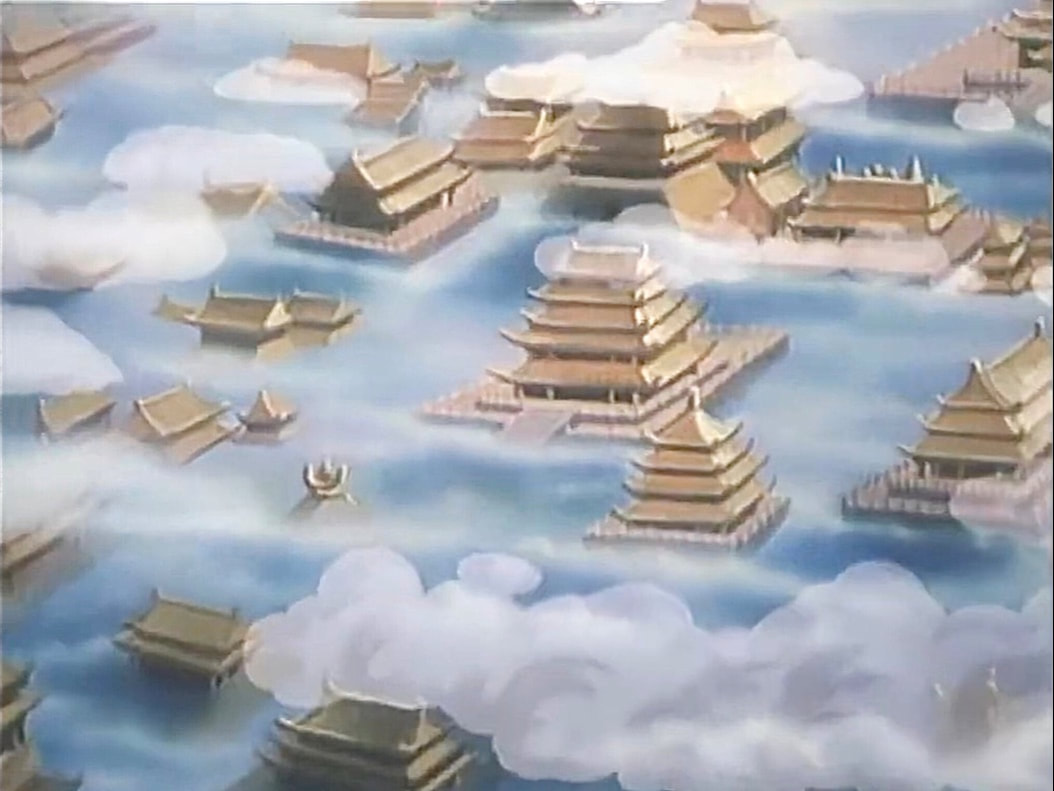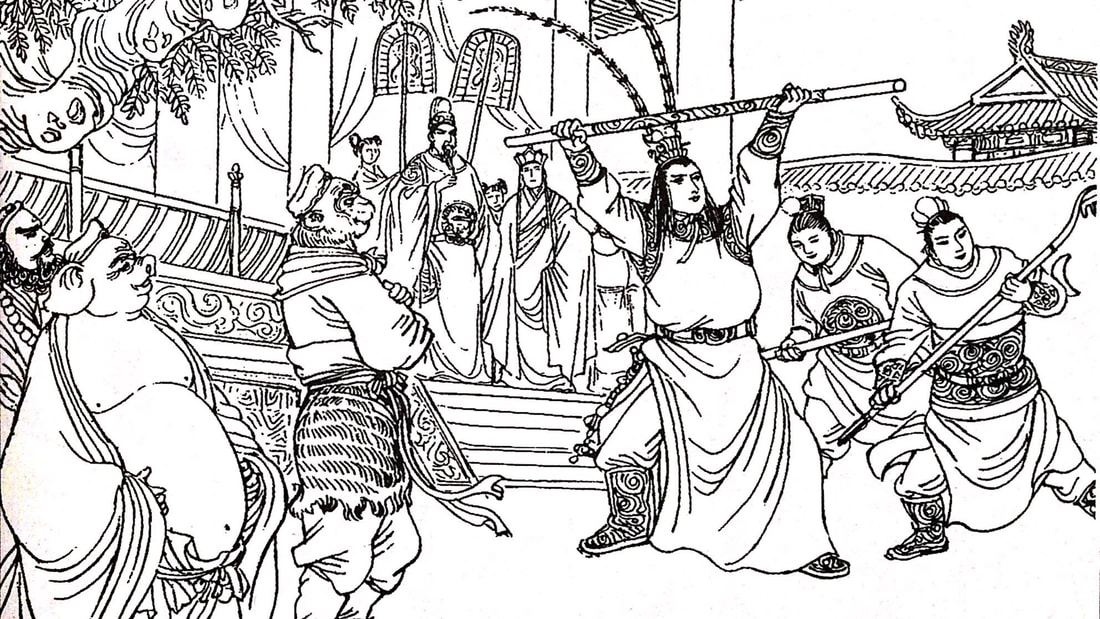|
Contents:
IntroductionEveryone knows of Sun Wukong and his ability of 72 Transformations, but what often goes unnoticed is that the significant number of 72 makes several other appearances in Journey to the West (1592). This number 72 is quite a particular one in traditional Chinese culture, and symbolises the idea of “supreme”, as this article will explain and provide examples for. 1. Mentions of 72 in the Journey to the West NovelThe significant number of 72 is mentioned in Journey to the West for a total of six times throughout the novel. I list and detail each of these appearances below. 1.1. Earthly TransformationsThe 72 Earthly-Fiend Transformations (qishi’er disha bianhua, 七十二地煞变化) is probably the most famous of all mentions of 72. This Daoist ability is one of the two known sets of transformations, the other being the 36 Heavenly. There are a total of three characters in Journey to the West who are mentioned to have mastered all 72 Transformations; these three are Sun Wukong [src. 2 & 5], the God Erlang (erlang shen, 二郎神) [src. 3 & 6] and the Bull Demon King (niu mowang, 牛魔王) [src. 4 & 7]. “Besides your immortality and your transformations,” said the Buddhist Patriarch [Tathagata], “what other powers do you have that you dare to usurp this hallowed region of Heaven?” “I’ve plenty of them!” said the Great Sage. “Indeed, I know seventy-two transformations and a life that does not grow old through ten thousand kalpas. I know also how to cloud somersault, and one leap will take me one hundred and eight thousand miles. Why can’t I sit on the Heavenly throne?” "[...] Dear Demon King [Bull]! He, too, was capable of undergoing seventy-two types of transformation, and his martial skill was about the same as that of the Great Sage, albeit his body was huskier, less agile, and not as nimble. Putting away his treasure swords, he recited a spell and, with one shake of his body, changed into the exact appearance of Eight Rules [Pigsy].
1.2. Caves on Flower-Fruit MountainA minor fact that not many have heard of, Sun Wukong’s Water-Curtain Cave actually isn’t the only cave on Flower-Fruit Mountain. Flower-Fruit Mountain is a big mountain on a large island, and in fact the novel states that there are a total of 72 caves there, excluding the Water-Curtain Cave which is hidden behind a waterfall [src. 8]. Led by the various demon kings of no fewer than seventy-two caves, they all came to pay homage to the Monkey King. Henceforth they brought annual tributes and answered the roll call made every season. The Mount Huaguo tourist attraction in Lianyungang (连云港), Jiangsu province, China, also hosts a site named the Seventy-Two Caves [src. 9]. This natural phenomenon was formed over millions of years by the geological process of orogenesis, creating a mass amount of caves. The site is named the Seventy-Two Caves in honour of the location of the same name in Journey to the West. 1.3. Demon Kings on Flower-Fruit MountainRelating to the point in para. 1.2 above, the 72 caves of Flower-Fruit Mountain each have their own demon king cave masters. When Monkey demonstrates himself to be the most powerful demon king on Flower-Fruit, these 72 demons all submit to him. They and Monkey have good relations [src. 10-11] and fought beside him during the war against Heaven, before all of them were arrested by celestial forces. Look at that Monkey King returning to his mountain in triumph! The monster kings of seventy-two caves and the six sworn brothers all came to congratulate him, and they feasted jubilantly in the blessed cave dwelling. 1.4. Halls in the Celestial PalaceThe first description of Heaven the novel is detailed in a lengthy poem, which describes the aesthetics and features of the surroundings. One line of the poem mentions there to be 33 layers of Heaven with a sum of 72 divine palace halls [src. 12]. These halls each have their own usage, with some as residencies for imperial figures, and others as departments for official businesses [src. 13-14]. […] 1.5. Styles of Weapon MovementThere are many ways to wield a weapon in action, notably for injuring, defending, disarming, or even simply performing for aesthetic display purposes. The novel notes that there are 72 possible methods to wield each of Monkey, Pigsy and Sandy’s weapons. When the pilgrims arrive at Jade-Flower District (yuhua zhou, 玉华州), the three disciples take in the three young princes of the city as their martial arts students [src. 15]. The students each practise with their respective master’s weapon, and soon familiarise themselves with all 72 styles of it [src. 16]. In a few days those three princes became thoroughly familiar with their drills and exercises. All the methods of offense and defense, fast and slow, indeed all seventy-two styles of movement that belonged to each weapon were mastered. 1.6. Generals Battling Monkey [1]During the peak of Wukong’s rebellion against Heaven, the Jade Emperor deployed the greatest celestial military force to arrest him. There were 72 celestial gods in this army who all served as vanguard generals [src. 17]. This is excluding the Pagoda-Bearing Heavenly King (tuota tianwang, 托塔天王) and the Four Great Heavenly Kings (sida tianwang, 四大天王), who were positioned as commanders [src. 18]. […] the Jade Emperor was furious. He at once commanded the Four Great Devarājas to assist Devarāja Li and Prince Naṭa. Together, they called up the Twenty-Eight Constellations, the Nine Luminaries, the Twelve Horary Branches, the Fearless Guards of Five Quarters, the Four Temporal Guardians, the Stars of East and West, the Gods of North and South, the Deities of the Five Mountains and the Four Rivers, the Star Spirits of the entire Heaven, and a hundred thousand celestial soldiers. 1.7. Honourable Mention: Weight of the HalberdAlthough it isn’t a direct mention of the number 72, the heaviest weapon belonging to the Dragon King of the East Sea (donghai longwang, 东海龙王) carries a weight with significant figures of 72. The weapon is called the Halberd of Square-Sky (fangtian huaji, 方天画戟) [2] and it weighs a whopping 7200 catties [3] [src. 19-20]. Monkey was offered this weapon by the Dragon King to keep as his own, but astonishingly, the 7,200 catty weight was much too light for him [src. 21]. This weapon appears later in the novel as the weapons of Fox the Seventh (hu aqi, 狐阿七) and the Golden-Winged Great Roc (jinchi da pengdiao, 金翅大鹏雕) [src. 22]. The Dragon King was becoming rather fearful; he ordered a bream admiral and a 2. Other Notable Mentions of 72
3. Why the number 72 is so SignificantThe number 72 is the multiplied product of the numbers 8 and 9, both being the highest single-digit numbers and representing the forces of Yin and Yang, respectively. In Daoism, the combination of Yin and Yang conveys a concept relating to the idea of the “ultimate” or “supreme”. 3.1. The Origin of the Earthly Fiends' numberThe Earthly Fiends (disha, 地煞) is what Monkey’s 72 Earthly-Fiend Transformations are named after. The Earthly Fiends are the 72 stars of evil in traditional Chinese astrology. This notion originated from the fallen Earthly Fiend stars, who were 72 of the 108 heroes of the Water Margin novel, which has had many references made in Journey to the West. Please see the article in the following link for more info on para. 3-3.1: Archive # 11 – The Origin of Sun Wukong’s 72 Transformations ConclusionThe number 72 has made important appearances in Journey to the West, ranging from being the number of the Monkey King’s transformations, to the total of palace halls in Heaven, to the weight of a legendary weapon. 72 is a greatly significant number in not just Journey to the West, but also in general Chinese culture, really demonstrating its symbolism of “supreme”. - Notes[1]
A big thanks to Jim R. McClanahan for suggesting this fantastic point. [2] Halberd of Square-Sky (方天画戟) Also translated as: Fangtian Ji, Trident Halberd. This is an ancient Chinese pole-arm, similar to a spear but with added crescent-moon blades on both sides of the spearhead. The whole head itself is designed to horizontally resemble the Chinese ideogram 天 (tian, lit: sky), hence its name “square sky”. This weapon was culturally popularised by the great warrior Lü Bu from the story of the Three Kingdoms. [3] 7200 catties (七千二百斤) Elvin (2004) notes that one catty (jin, 斤) from the Ming dynasty, when the novel was written, equates to 590 grams. Therefore, 7,200 catties would equal to 4,248 kg or 9,365 lbs. [4] Cao Cao (曹操) Cao Cao (155-220 AD) was a Chinese warlord and later Prime Minister during the end of the Han dynasty (202 BC-220 AD). He rose to great power and founded the Wei kingdom (220-266 AD), which succeeded the Han. [5] Liu Bang (刘邦) Liu Bang (256-195 BC) was the founder of the Han dynasty after successfully challenging the reigning Qin dynasty (221-206 BC) and defeating the opposing forces of Xiang Yu (232-202 BC, 项羽). [6] Biographies of the Immortals (列仙传) Also translated as: Liexian Zhuan (lit: chronicle of the list of immortals) Biographies of the Immortals was written by Liu Xiang (77-6 BC). It is the oldest known commentary on Daoist immortals, and the time it was written is unknown. [7] Confucius (孔子) Literal meaning (Chinese): Master Kong. Also translated as: Kongzi, Kong Tzu. Confucius (551-479 BC), real name Kong Qiu (孔丘), was a philosopher during China’s Spring and Autumn period (771-476 BC, chunqiu, 春秋), as well as the founder of Confucianism (a.k.a. Ruism), a religion based on personal ethics and good morals. [8] six arts (六艺) The six arts of Confucian teachings are: rites (li, 礼), music (yue, 乐), archery (she, 射), charioteering (yu, 御), literacy (shu, 书) and arithmetic (shu, 数). [9] hou (候) A hou is a measurement of time in traditional China. One hou equals to a period of five days. [10] Another big thanks to Jim R. McClanahan for pointing this out to me.
0 Comments
Leave a Reply. |
Explore the appearances and origin of the number 72, one that is quite significant to the Journey to the West novel.
Author
Irwen Wong |










